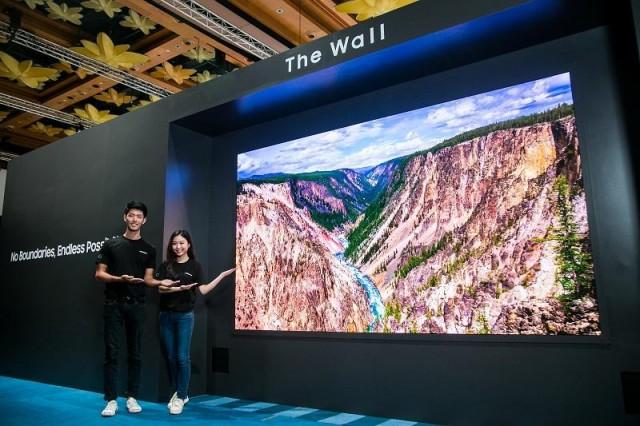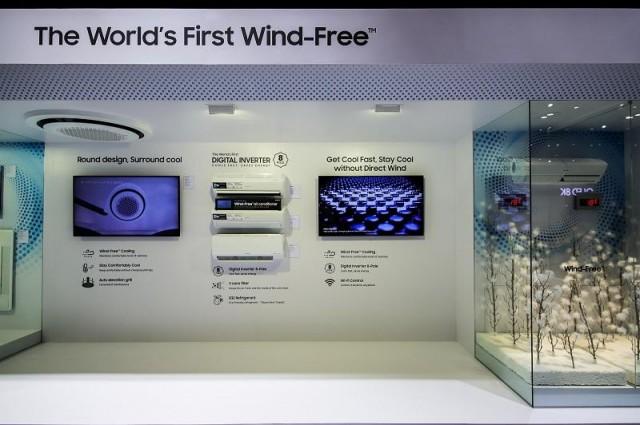Is the Pinoy family ready to embrace 'smart' technology?
Strolling through the incredible product exhibition at the recent Samsung Forum 2019 in Singapore made me feel like the proverbial kid in a candy store.
The mammoth showcase occupied 2,470 sqm of Resorts World Sentosa’s ballroom, highlighting the tech giant’s newest offerings for 2019 as well as its recent, sometimes region-specific products.
A wall-sized television (appropriately called “The Wall”) welcomed forum attendees into the exhibition room. It’s so big, one needs to stand some 15 feet or so to appreciate everything that’s going on in front of you.

It also features a modular design: you could talk to your friendly neighborhood home renovator and plan how you want it to look when it’s installed on your wall: a small square to fit your sala, perhaps, or its entire, full-sized 16:9 glory?
Prior to entering the expansive demonstration area, I sat through an engaging press conference that spotlighted Samsung’s latest additions to its Family Hub line of “smart” products: huge televisions that doubled as virtual art galleries, soundbars capable of recreating the audio experience of your favorite cinema, and refrigerators that could give you recipe recommendations and chill room-temperature drinks in mere moments.
Even better, these devices work with each other, creating a home environment of interconnected devices making life easier for you.
As an average Filipino raised in a household with a sometimes-working, sometimes-wonky TV and an electric fan that sometimes needed a little banging to work properly, the idea of a home full of intelligent devices is a fresh one to me.
“For the most part, I believe that Filipinos have a deeper appreciation for cutting-edge technology,” said Patrick Tolentino, Samsung Philippines’ Chief Marketing Officer and the patient soul who answered most of my questions during the whole-day event. “As we are still a developing country, we get excited to see and experience how it can better shape our reality.”
Out of the vast assortment of gadgets and appliances there, though, a particular product line caught my eye — one that, as of this writing, has not been made available in the Philippines yet: Samsung’s air purifier line.
Clearing the air
The salespersons manning the booth were very helpful in explaining how the air purifiers work: They come equipped with the same powerful capabilities as their Wind-Free Air Conditioners, their filters capable of collecting ultrafine air particles.
The square-shaped models are even stackable, designed to be a space-saving choice appropriate for smaller Asian homes.
Air purifiers are quite popular in the Philippines. Why hasn’t Samsung brought in theirs yet?
According to Patrick, local product teams align with Samsung HQ to identify product line-ups per market within particular time frames.
“For each market we look into, we study its readiness for new technology and/or the demand for it. These factors give us an idea of a particular product's potential size of business. Such is the case for the Philippine market, where we mainly look at its readiness for advanced technology. Of course, the pricing of the products also play a factor.”
As Patrick explained, it likely boils down to two things: How much people want a particular product, and how much they’re willing to pay for it.
_2019_04_11_13_37_40.jpg)
This raises a few interesting questions, though — and not just about Samsung’s products.
We mean: How ready and how open are Filipinos in terms of embracing these new “smart” technologies.
The Internet of Things
It may still sound like straight out of science fiction, but the idea of the Internet of Things — or IoT, for short — isn’t that new. In fact, it’s been around since 1999.
Tech entrepreneur Kevin Ashton came up with the term when he was working at Procter & Gamble as an assistant branch manager. He wanted to use Radio Frequency Identification (RFID), a system of identifying people or objects through radio waves, to improve how the company creates and distributes its products. He thought up the phrase “Internet of Things” as the title of his presentation.
The premise of IoT is straightforward: it is, quite literally, a collection of things connected to the internet.
By storing and sharing data through the internet (in this case, referred to as the “cloud”), IoT-capable machines can perform basic functions on their own, based on your preferences.
If this concept feels foreign to you, it’s because having fully IoT-integrated homes is still quite far-off.
In fact, Samsung is one of only a handful of manufacturers focusing on IoT as “smart home solutions”—though of course, they’re not claiming ownership of that idea.
“We would like to think that we are paving the way to a future-ready Filipino home by making our consumers’ lives more seamless and connected,” says Patrick.
The centerpiece of the exhibition is a small area designed to look like a typical living space, highlighting how the Family Hub concept would work.

Picture this scenario: On a hot summer day, you walk into your living room and greet Bixby, Samsung’s personal AI assistant. You sit down, ordering your 65-inch 8K QLED TV to flip through your favorite channels — Bixby knows because it can distinguish your voice from your mom’s — as your Wind-Free Air Conditioner starts cooling your room.
Then you ask your refrigerator to give you a list of what’s inside it; suggested recipes follow. You then get the necessary ingredients for a sandwich, and stuff the drink you pulled off your shelf into the Freeze Zone. After a few moments, you take out your drink, as you proceed to make your snack and enjoy the rest of your afternoon.
According to Patrick, other countries have already taken the lead in “smart living” — and it’s not too late for us to catch up.
“I am convinced that the market is ready. Filipinos appreciate and understand new innovations like the Internet of Things,” affirmed Patrick. “I can even say that we are eager to fast-track our technology. As soon as the infrastructure for this is ready, I think we can see a big leap.”
With great power comes great… cost
More often than not, big technology entails big expenses. And in a country like the Philippines —beset with economic woes, a problematic transportation system, and the occasional resource or energy supply issue — it’s not surprising for one to question the need to spend more money on a “smart” refrigerator.
But Patrick, benefits outweigh cost—especially considering what’s to come in the next five to ten years.
The Wind-Free Air Conditioners, for example, save energy by running more efficiently even with high summer temperatures.

Meanwhile, the Automatic Washing Machines generate a multi-directional washing flow that, according to Samsung, increases power, prevents tangling, and cuts washing time considerably.
“We start imagining the possibilities of how better our lives can be,” Patrick added. “At the same time, we carefully base our purchase decisions for technology, based on how it can help us overcome current challenges.
“So, the evaluation process becomes two-fold: we determine whether a product is practical for present conditions, and if it is a worthwhile investment for the future.”
The road to IoT in the Philippines: paved with problems?
But more than cost of smart appliances, a bigger concern especially for a country like the Philippines is the quality of Internet: What happens to the interconnected appliances when it suddenly goes kaput, as it is wont to do?
With a smile, Patrick explained that in such situations, the appliances would still function as they normally would, just without the bells and whistles that come with interconnectivity.
“Forces like this affect consumer decision making — if we can improve on these services, we can have an even more excited market that is willing to jump into and invest in new technology.”
A “smart” decision
It isn’t so far-fetched to think that under the right circumstances, Filipinos would dive head first into the waters of IoT. After all, as far as buying things is concerned, Filipinos seem to have a taste for the new and shiny.
Samsung’reveals smartphones are among its most successful products in the country. The company attributes this to Filipinos’ penchant for documenting their sights and experiences, communicating with friends and family, and listening to music or surfing the internet while on the move.
It would be a bit hasty to conclude that our love for talking to each other via our smartphones would automatically translate into wanting to talk to our homes.
But the brand is optimistic that the trend will catch on in the Philippines, as it prepares to unveil more smart products in the country in the years to come.
As Patrick put it succinctly: “There is no better time than now to start investing in smart technology.”
Now, if only we could get everyone’s internet connections to function properly, post-haste. — LA, GMA News



